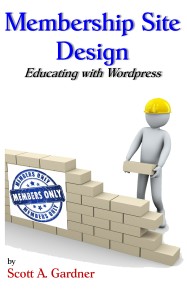 [This is an excerpt from my upcoming book, Membership Site Design.]
[This is an excerpt from my upcoming book, Membership Site Design.]
A basic WordPress installation, plus some basic text-based content, should take up less than 100 MB of space on your host’s server. However, unless you know you won’t be taking up that much space, I’d recommend going with at least 250 MB of space. This gives your site room to grow, and to store lesson content. I do not recommend going with a host who offers you “unlimited space.” Remember, they’re offering that to each and every one of their other customers too, and some of them are going to take as much space as possible. More importantly, they will also take the computing power of that server, leaving you with a slow-running site.
If you’re going to be serving video content as part of your lessons, space and speed are additional considerations. I would, however, suggest you store your videos on another site instead. Having some content on YouTube is great, but then everyone has access to that, registered member of your site or not. I’d put certain videos, like the welcome video for your free section, on YouTube where it will be indexed and reported on Google and other search engines, where people can trip over it and find you. There are cloud services like Amazon’s S3 service, or Google Drive, where you can store your videos, and Vimeo has semi-pro and professional options as well. I’d investigate those and choose the one best suited for our needs.
Each page on your site, and every post, has the option for readers to comment. Many membership plug-ins either restrict this automatically, or offer you the option of doing this on each post and page. If you want to interact with your members, or if you want them to interact with one another, letting them comment on each post or lesson is the simplest option. However, if you want to foster deeper discussions, and offer them more options for commenting – or just to natter back and forth – installing a forum plug-in might be the way to go. These require some additional setup on installation, and they’re another thing you or someone else is going to need to administer. However, for certain types of sites they can be invaluable.
Many sites now offer badges to members. A badge is simply a small picture that shows the user has finished some task. The Open Badges project web site is probably the best place to learn all about these. You can install a plug-in that awards badges to users upon completion of a lesson, course or level. Badges are still relatively new out there, and changes are taking place rapidly. If they’re something you want to offer your members, it’s best to stay up on the current discussions about them, and keep your software updated.
Speaking of finishing, you should have a plan for how you want the course or level to end. Maybe it’s a lesson that ties together all the other information you’ve presented. Perhaps it’s an interactive lesson where they show off what they’ve learned. Maybe it’s just a simple message of congratulations, or the awarding of a certificate or license. Maybe you have higher levels you want them to move to – that’s how many of the sites I set up end most levels or courses. Whatever it is, you should beginning planning for it now, and figure out how you want to present this to your members.
Once you’ve answered all of these concerns for yourself, you’ll be about 80% done with the planning process.

